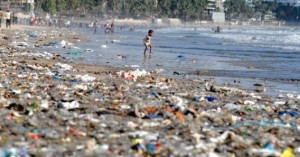 The Great Pacific Garbage Patch is a mess of trash and plastic that moves around the north Pacific Ocean and is roughly the size of Texas. It has a high concentration of plastics and chemical sludge. Photos from the patch of trapped sea turtles and tires will snare the attention of even the most stone-hearted cynic. A second plastic gyre has been discovered in the north Atlantic Ocean. And as Yahoo Green reports, another gyre was recently spotted in the Indian Ocean.
The Great Pacific Garbage Patch is a mess of trash and plastic that moves around the north Pacific Ocean and is roughly the size of Texas. It has a high concentration of plastics and chemical sludge. Photos from the patch of trapped sea turtles and tires will snare the attention of even the most stone-hearted cynic. A second plastic gyre has been discovered in the north Atlantic Ocean. And as Yahoo Green reports, another gyre was recently spotted in the Indian Ocean.
Ocean currents collect floating garbage and drop it into gyres that serve as a convergence spot. Trash has long washed up on the beaches of India, and now experts have confirmed that it may in part be due to a giant swirl of refuse making its way around the Indian Ocean.
Anna Cummins and Marcus Eriksen — co-founders of the 5 Gyres Institute, which is focused on plastic pollution in the oceans — report that of “the 12 water samples collected in the 3,000 miles between Perth, Australia, and Port Louis, Mauritius (an island due East of Madagascar), contain plastic.” As Cummins explained to Yahoo Green, “We now have a third accumulation zone of plastic pollution that shows compounding evidence that the trash isn’t condensed to an island. It’s spread out across the entire gyre from coast to coast.”
Often called the world’s largest dump, these oceanic gyres are comprised of anything and everything that goes into the sea. Discover Magazine refers to the Great Pacific Garbage Patch this way: “Around and around: bottles, plastic bags, fishnets, clothing, lighters, and myriad other man-made items, held until they disintegrate, make their way to distant seas, or merely bob among the waves before washing up on someone’s beach.” In the North America alone, over 14 billion pounds of trash go into the ocean each year. The U.S. Coast Guard estimates that merchant ships dump 90 percent of the waste, while recreational boaters, the military, and cruise ships contribute the rest — with a 1 percent dose of sewage thrown in.
So where does this leave the Indian Ocean Garbage Patch? Eriksen emphasizes the importance of stopping the flow of trash into our bodies of water. These gyres are almost impossible to clean out because they do not form a solid base of trash. Eriksen also suggests cleaning up beaches as quickly as possible to prevent trash from entering or returning to the water. Another solution — collective reduction in individual plastic consumption — would also help create cleaner bodies of water.
In the meantime, the 5 Gyres Institute plans expeditions into the southern hemisphere to look for more trash.
Katherine Butler
Full article url: http://www.mnn.com/earth-matters/wilderness-resources/stories/new-ocean-garbage-patch-discovered


